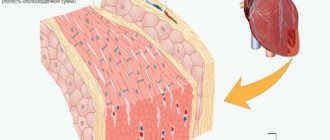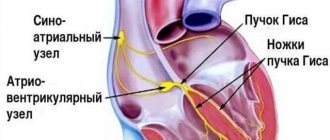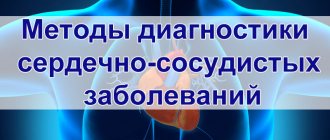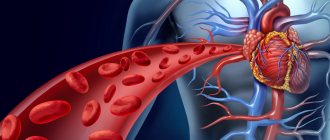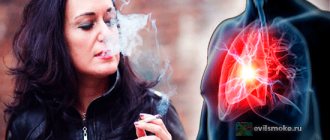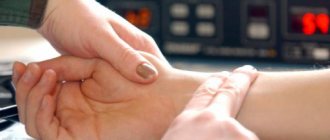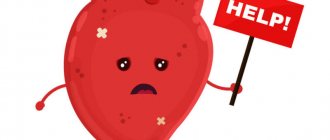General information
The Manual of Diseases of the Autonomic Nervous System defines paroxysms as paroxysmal manifestations of autonomic, emotional, behavioral and cognitive disorders over a relatively short period of time.
The autonomic nervous system regulates the functioning of internal organs, exocrine and internal secretion glands, lymphatic and blood vessels. The autonomous department of the nervous system is responsible for the activities of all organs and the system as a whole. The human will is unable to influence the work of the autonomic department. Absolutely all autonomic functions are subordinate to the central nervous system and, first of all, to the cerebral cortex.
Main functions of the vegetative department:
- regulation of metabolism , metabolism;
- regulation at the nervous level of all tissues and organs (with the exception of skeletal muscles);
- ensuring adaptive reactions;
- maintaining normal homeostasis in the body.
The structure of the vegetative region
Functionally and anatomically, the autonomic nervous system is divided into several sections:
- sympathetic;
- metasympathetic;
- parasympathetic.
Paroxysmal activity of the brain is the electrical activity of the cerebral cortex, in which an excess of excitation processes over inhibition processes is recorded in one of the brain regions. The paroxysmal state is characterized by a sudden, sharp onset, an extremely rapid course and an equally sudden end.
Paroxysmal disorders are divided into 2 types of paroxysmal activity:
- epileptic (associated with epilepsy);
- non-epileptic (associated with the autonomic department).
Periodic paralysis (paroxysmal myoplegia) is a neuromuscular pathology characterized by periodically triggered attacks (paroxysms) of transient paralysis .
How do the sympathetic and parasympathetic nervous systems work? Features and main differences
The sympathetic and parasympathetic nervous system, its structure is unique and individual for each person. The activity of the departments will largely depend on age and health status. The neural impulse moves in a strictly specified direction. This movement is based on a reflex arc in the form of a closed chain of neurons. The work of the departments can be seen using a clear example: receptors on the skin detect an irritant in the form of cold, transmit the received data along nerve fibers to the central nervous system, where it is analyzed and evaluated. After which it is these two main departments that make the decision on the impact on the emerging stimulus. In our example, this is a person’s need to warm himself so as not to get too cold and protect himself from the cold. The impulse is transmitted along the nerve endings to the central section, and from there to the peripheral, where the impact occurs as a result of the stimulus - the skin becomes “goosey”, active muscle contraction occurs, aimed at warming the whole body under the influence of cold.
Pathogenesis
The main role in the pathogenesis of paroxysms is played by autonomic imbalance , which occurs as a result of a violation of autonomic regulation. According to the widespread concept of Selbach, there is a kind of “swinging balance” between the parasympathetic and sympathetic parts of the nervous system: when the tone of one part increases, the activity of the other increases. Thanks to this balance, it is possible to maintain homeostasis and create certain conditions that ensure the lability of physiological functions.
Using the experimental method, it was possible to prove the lability of all systems: blood pressure, heart rate variation, temperature, etc. The autonomic system becomes vulnerable when these fluctuations go beyond the homeostatic range. Endogenous and exogenous stimuli overstrain regulatory systems, which leads to their breakdown, “disintegration” with special clinical symptoms in the form of vegetative paroxysms.
Rules for removing alcohol from the body
After a single drink of alcohol, unpleasant symptoms are observed - a person shudders, headaches and nausea appear.
To improve the condition, it is enough to go through 2 recovery stages. The first of them is carried out the next day. First of all, the breakdown products of ethanol need to be removed from the body. If you have exceeded the usual dose of alcohol, the following remedies will help you quickly cleanse your body and improve your health:
- Diuretics, laxatives, and sorbents are suitable to remove breakdown products from the blood and intestines. It is also worth taking substances that speed up the Krebs cycle. These include succinic acid, fermented milk products, tincture of Eleutherococcus.
- The lack of fluid will be quite severe. Oral replenishment is not recommended as it may place excess stress on the kidneys. If possible, it is worth putting in an IV with glucose and saline solution.
The next stage of recovery involves replenishing the lack of vitamins and minerals. The fact is that after drinking alcohol, B vitamins, magnesium, potassium, and calcium are washed out of the body.
To replenish their reserves, you will need a course of appropriate medications - for example, pentovit or asparkam. As a rule, these activities will be enough to recover from a single drink of alcohol. After prolonged drinking, the functioning of the main organs suffers, which is why it is so important to take more serious measures that will help restore memory, liver function, kidney function, etc.
Classification
According to the flow it is customary to distinguish:
- paroxysmal vegetative-vascular dystonia (symptoms appear episodically, during paroxysms and attacks);
- permanent vegetative-vascular dystonia (symptoms are constantly present).
If there are signs characteristic of both types, then they speak of a permanent-paroxysmal course, in which paroxysms occur against the background of sluggish symptoms.
It is customary to distinguish several types of crises:
- Vagoinsular paroxysms . Characterized by a decrease in blood pressure, slowing or accelerating heart rate ( bradycardia / tachycardia ), dizziness , hyperhidrosis . Fainting is a type of vagoinsular paroxysm.
- Sympathetic-adrenal paroxysms . Characterized by hyperthermia , rapid heartbeat, increased blood pressure, chills-like hyperkinesis , pain in the heart area. Attacks usually end with the release of light-colored urine in a large volume.
- Mixed paroxysms . Combines the features of the two previous options. Symptoms can naturally replace each other. In a certain group of patients, crises occur only during the daytime, in others - at night.
Other nervous diseases
There are a number of diseases of the nervous system that occur much more often in alcoholics than in other people. These are, first of all, epilepsy, inflammation of the meninges (meningitis), hemorrhage in the brain (stroke). According to statistics, the frequency of epileptic seizures in alcoholics ranges between 5 and 35%. Withdrawal increases the severity of cramps. Meningitis is quite common in this population - about 16%. Approximately 3–4 times more often than the average statistical indicators, strokes associated with both narrowing of cerebral blood vessels (infarction) and cerebral hemorrhage occur. This is facilitated by a number of disorders associated with the effects of alcohol on the hematopoietic system.
Pancreas
When alcohol abuse occurs, the pancreas suffers no less than other major organs. But with the right approach, it can be easily restored. This organ reacts sharply to violations of diet and eating patterns. If you need to restore it after a one-time alcohol abuse, then a few “hungry” days may be a good solution.
If you need to help a former alcoholic, then you should develop the habit of eating often, but in small portions. Avoid heavy foods. Love drinking water. Be sure to drink a glass of water 30 minutes before meals. Give preference to steamed food.
Kidneys
Long-term alcohol abuse also negatively affects the urinary system. Kidney failure may develop due to alcohol settling in the kidney structures. But this organ is also capable of self-healing if you completely stop drinking. It may take up to 8 weeks for your kidneys to function as before.
In order for the kidneys to quickly restore their function, it is important to give preference to a gentle diet, as well as to establish a good drinking regime. In addition, an active lifestyle and moderate physical activity will speed up metabolic processes, which will have a positive effect on positive dynamics.
Causes
Paroxysms are most often just a manifestation of certain diseases. Paroxysms may be a reflection of dysfunction of the autonomic nervous system.
Paroxysms are triggered against the background of neuroses and some organic brain lesions:
- dysfunction of the vestibular apparatus;
- hypothalamic disorders.
In some cases, attacks accompany migraine and temporal lobe epilepsy. They induce paroxysmal affect and allergic reactions .
What is the parasympathetic nervous system responsible for?
The human body tends to adapt to stimuli that surround us at almost every step. Moreover, adaptability in each specific case will look different and have the opposite character. For example, the summer heat would have an adverse effect on the human body, if not for its ability to cool down due to increased sweating; in the cold season, sweat production stops and the mechanism of maximum heat retention in the cells is activated. Therefore, the functions of the sympathetic and parasympathetic nervous systems are different and opposite, aimed at the body’s ability to turn on or off a certain “option” at a certain moment.
Symptoms of diseases of the autonomic nervous system
Sympatho-adrenal paroxysms are characterized by a sudden onset, without warning signs. Most often, an attack occurs after a sleepless night or overstrain (emotional, physical, mental). Main manifestations:
- pale skin;
- mydriasis;
- polyuria;
- trembling, chills in the body;
- dry mouth;
- cold extremities;
- hyperglycemia (rare).
The paroxysm begins and ends with pronounced disturbances in the functioning of the cardiovascular system (instability of blood pressure, tachycardia , shortness of breath ). The patient recovers from paroxysm slowly, over several hours.
Vago-insular paroxysms are characterized by:
- labored breathing;
- drop in blood pressure ;
- feeling of lack of air;
- lethargy;
- hypoglycemia;
- nausea;
- disturbances in the digestive tract;
- hyperhidrosis;
- drowsiness.
Patients quickly recover from paroxysm and recover from the attack. During the first two hours after a crisis, there may be adynamia , drowsiness , sweating and vasomotor disorders.
In the mixed form, symptoms characteristic of the two attacks described above are recorded. The hypothalamic origin of attacks is determined by such manifestations as:
- polyuria;
- bulimia;
- hyperthermia.
In the interictal period, endocrinological diseases and neurotic symptoms can be recorded. Mild neurological symptoms include:
- sluggish abdominal reflexes;
- anisoreflexia;
- asymmetry of nasolabial folds;
- anisocoria.
The behavioral status of the patient during an attack depends on his social appearance, culture and personality structure. Each patient has a different severity of autonomic disorders. Some people experience a deepening of neurotic symptoms during and after a paroxysm. With hypothalamic dysfunction (dynamic and morphological form), sympathetic-adrenal paroxysms are more often recorded and mixed paroxysms are extremely rare.
Damage to the nervous system due to alcoholism
The most common and pronounced damaging effect of alcohol is on the organs of the nervous system. The pathological process may involve both the brain and spinal cord, and peripheral nerve pathways. Significant damage to the nervous system due to alcoholism is possible even with the acute poisoning described above and the state of abstinence. A wide range of negative effects of alcoholic beverages are possible with their chronic abuse.
The following mental changes are most often noted: disturbances in attention, orientation (primarily spatial), concentration, memory (most often oral), learning, abstract thinking, and the ability to solve problems. Motor functions are impaired, especially the ability to perform fine movements. Usually there is damage to various brain structures, manifested in a variety of manifestations. The above picture can be supplemented with such symptoms as a decreased desire for cognitive activity. With deeper damage to brain structures, we are talking about a serious illness - dementia.
Tests and diagnostics
It is extremely important to make a differential diagnosis between paroxysm of the autonomic nervous system and diencephalic (hypothalamic) epilepsy or other hypothalamic . In some cases, this can be extremely difficult; several factors and circumstances must be taken into account.
During hypothalamic epilepsy, convulsions are observed and loss of consciousness occurs (even short-term). Epileptic seizures are characterized by frequent and short repetitions, usually at night. They are not associated with overwork or overstrain.
Electroencephalography is important in differential diagnosis. In individuals with hypothalamic epilepsy, EEG in the interictal period reveals specific changes in the form of epileptic discharges in the oral part of the brain stem. The described electroencephalographic criterion is considered the main one for confirming hypothalamic epilepsy .
To establish the exact nature of a vegetative attack (epileptic or non-epileptic), the doctor also needs to study the patient’s behavior after the attack, understand the patient’s personality, and get to know his family to identify “minor” epileptic signs.
Autonomic paroxysm may occur as a result of involvement of the limbic system in temporal lobe epilepsy and be an aura. In such cases, attacks are stereotypical, short-lived and often manifest as isolated disturbances of any visceral function. Also, the diagnosis of vegetative attacks requires the exclusion of pathology of internal organs (especially in the heart). It is important to exclude hysteria and arterial hypertension .
Consequences of regular alcohol intoxication
As mentioned earlier, the nervous system is an important conductor in communication between organs and the brain. Drinking alcohol, even in small doses, causes enormous damage to health.
Intoxication and hangover are the primary results of the effects of ethanol on the brain and the rest of the periphery. The main destruction occurs internally at the cellular level and is cumulative.
Periodic exposure to alcohol on nerve cells develops pathological changes that lead to significant and even irreversible consequences in the brain. Decreased health indicators are a common occurrence with alcoholism. Absolutely all vital functions of the body are affected by intoxication: vision, hearing, blood supply, metabolic processes.
Like a strong poison, alcohol destroys cells. In addition to physical ones, mental pathologies are also observed.
People who drink alcohol eventually suffer from nervous disorders, insomnia, and depression. In especially severe cases, delirium tremens develops. The person experiences auditory and visual hallucinations that can lead to self-harm.
In addition, mental activity and quality characteristics decrease. Antisocial behavior in the family and at work is manifested by aggression, selfishness and indifference. The general degradation of man is gradual, but on an increasing scale.
Alcohol has a complex effect on the human nervous system, reducing health indicators and personal qualities. Relieving fatigue and nervous tension with a glass of strong drink is a high price that will have to be paid in the near future.
The negative effect of alcohol on the nervous system is beyond doubt. Moreover, ethanol is harmful to health even in minimal quantities. The nervous system is depressed due to a decrease in the sensitivity of nerve fibers. Alcohol causes artificial relaxation, which leads to a deterioration in the functions of the central nervous system.
Loss of elasticity of nerve fibers causes constant tension. A person loses stress resistance, has a hard time experiencing any troubles, often has a bad attitude and is prone to depression. People who regularly drink alcohol are characterized by inappropriate behavior, show excessive anxiety, are depressed and are characterized by psycho-emotional instability. This condition requires constant consumption of alcohol, which artificially simulates the human nervous system, causing an irresistible addiction.
Prevention, how to strengthen the autonomic nervous system?
Patients prone to paroxysms should be more attentive to their own health, listening to all symptoms and changes in the functioning of the body. Following simple recommendations will strengthen the autonomic nervous system and avoid paroxysms (or reduce their number as much as possible).
- Start your day with a contrast shower. A light morning manipulation will not only improve your well-being and mood, but also replenish your energy supply. For a beginner, it is enough to splash yourself with cold water after taking a shower. Taking a pine bath before bed has a good effect, which ensures maximum relaxation.
- Complete cessation of smoking and drinking alcoholic beverages. Nicotine promotes vascular spasm, and alcohol negatively affects the functioning of the nervous system.
- Take vitamin complexes in courses. Vitamin A , B vitamins , as well as ascorbic acid ( Vitamin C ) have a positive effect on the functioning of the nervous system.
- Do yoga. Relaxing technique normalizes the functioning of the autonomic nervous system
- Walk outdoors regularly.
Stress protectors help prevent paroxysms. It is for this purpose that daytime tranquilizers are prescribed. Anticonvulsants, some neuroleptics, antidepressants and benzodiazepine tranquilizers are prescribed to correct the patient’s psycho-emotional state. The above drugs have a positive effect on the “stagnant” circulation of nerve impulses and areas of increased excitability.
Antidepressants have sedative, thymoanaleptic and anxiolytic effects, block the reuptake of serotonin and norepinephrine .
Psychotherapy also helps to correct the patient’s psycho-emotional state and change personal attitude towards traumatic factors.
The mechanism of alcohol's effect on the nervous system
After consumption, alcohol is absorbed by the walls of the stomach and enters the bloodstream. Due to its circulation, ethanol quickly spreads throughout the body. Once in the brain, it is absorbed by lipids and causes severe poisoning until it completely disintegrates.
In the normal state, the processes of excitation and inhibition of the human nervous system are in balance. Alcohol has a stimulating effect, which during drinking manifests itself in:
- high spirits, feeling of fun;
- self-confidence;
- excessive talkativeness;
- carrying out impulsive actions;
- loss of coordination of movement (starting from 0.1% concentration);
- hectic.
The more a person drinks, the less adequate his behavior becomes, even to the point of complete loss of consciousness. This condition lasts throughout the entire process of alcohol absorption by the stomach.
When the maximum amount of ethanol is in the brain, and its content in the blood drops, a person experiences the following conditions:
- irritability;
- aggression;
- inability to speak coherently;
- impaired coordination of movements.
This is how the process of inhibition begins, and degeneration of the nervous system caused by alcohol occurs.
If the level of alcohol in the blood reaches a fatally high level, paralysis occurs in the centers of the medulla oblongata, which is responsible for blood circulation and breathing.
Sympathicotonia: causes, manifestations, diagnosis, how to treat
© A. Olesya Valerievna, candidate of medical sciences, practicing physician, teacher at a medical university, especially for SosudInfo.ru (about the authors)
Sympathicotonia is manifested by an increase in the tone of the sympathetic department of the autonomic nervous system with the appearance of characteristic symptoms - hypertension, tachycardia, fever, hunger, etc. It can be one of the manifestations of a mixed version of autonomic dysfunction or an independent form of pathology, and often requires medication and even surgical treatment .
Sympathicotonia is not considered a disease; it is a complex symptom complex due to functional disorders of autonomic regulation, which can occur against the background of another pathology or even for no apparent reason. However, this disorder cannot be left without attention, because its complications can pose a threat to the patient’s life, provoke neuroses and significantly reduce the quality of life.
Diagnosis of increased tone of the sympathetic nervous system sometimes presents certain difficulties, since the symptoms are quite varied and it is often difficult to relate one to the other, “fitting” the clinical picture into a specific disease. The diagnosis can be made by excluding pathologies of many organs (gastritis, bronchitis, arrhythmia, neurosis, etc.).
Before the fact of a functional disorder of sympathetic regulation is established, some patients manage to examine almost all organs, having done an ultrasound of the abdomen and retroperitoneum, gastro- and colonoscopy, a cardiogram, undergoing various tests and visiting specialists. Only when it becomes clear that the organs are completely healthy, specialists are convinced of the functional causes of the pathology.
Sympathicotonia is a manifestation of autonomic dysfunction (VSD), in which increased tone of the sympathetic department dominates among the manifestations. VSD as a diagnosis is not included in disease classifications, but is extremely common in people of all ages.
According to some reports, up to 80% of the population suffers from this disorder, and at least a third of them need the help of specialists and prescription of medications.
Among the patients, there are several times more women; symptoms are more pronounced in children, adolescents, during menopause and pregnancy.
departments of the autonomic nervous system are normally in balance; with sympathicotonia, the sympathetic department is more active
Causes of sympathicotonia
The causes of hypersympathicotonia are extremely varied:
- Hormone-producing adrenal tumors (pheochromocytoma);
- Stressful situations, worries, nervous overstrain, neurasthenia;
- Brain pathology and increased intracranial pressure;
- Unfavorable environmental situation, radioactive radiation;
- Changes in climate zones, frequent long-distance flights;
- Pathology of the cervical spine;
- Brain injuries, neuroinfections;
- Hormonal imbalance in adolescence, premenopausal age, during pregnancy;
- Hereditary predisposition (primary sympathicotonia);
- The pathological course of childbirth and the early postpartum period is hypoxia, trauma, infectious pathology.
As you can see, both external unfavorable factors and diseases of internal organs and the endocrine system lead to a disorder of nervous regulation, but, perhaps, the most common causes are stress, anxiety, and neuroses. With the development of autonomic dysfunction such as sympathicotonia in connection with various other pathologies, they speak of the secondary nature of this form of VSD.
Manifestations of sympathicotonia
Sympathicotonia occurs:
- Generalized, when symptoms come from many organs and systems;
- Systemic - symptoms are limited to a violation of one of the body systems;
- Local.
Depending on the course of the disorder, a latent form, constant and paroxysmal, is distinguished, while according to the severity of symptoms, mild, moderate and severe sympathicotonia are distinguished.
The manifestations of sympathicotonia are very diverse, often confusing the patient who does not know what to complain about, because literally all organs are disturbed, however, it is this diversity that suggests a violation not in the organs themselves, but in their regulation by the nervous system .
Signs of sympathicotonia are:
- Tendency to increase blood pressure;
- A slight increase in body temperature to 37-37.5 degrees;
- Feeling hot;
- Acceleration of pulse and breathing;
- Paresthesia, tingling, sensation of loss of sensitivity in different areas of the body;
- Constipation;
- Decreased sweating and therefore dry skin;
- Shiny eyes, dilated pupils and possibly bulging eyes;
- Increased appetite along with weight loss;
- Cranialgia, migraine;
- Dizziness, attacks of loss of consciousness;
- Pronounced weather sensitivity.
Changes in the psycho-emotional state are very characteristic. Patients may experience causeless apathy, melancholy, have a pessimistic view of the present and future, suffer from depression, are irritable, hot-tempered, sleep poorly at night, but may be sleepy during the day, and are very afraid of death, so any symptom can provoke a panic attack.
People with a predominant tone of the sympathetic department of the autonomic nervous system are easily excitable, proactive, quite efficient, but often anxious and can flare up over a trifle. They react sharply to both heat and cold and are poorly adapted to overload, which significantly reduces their quality of life.
Complications of VSD of the sympathicotonic type are rare and only in advanced forms of the disorder, when treatment was not carried out or was started too late. They are most often associated with high blood pressure and hypertensive crises, which can provoke cerebral hemorrhage, heart attack, and dyscirculatory encephalopathy.
A serious manifestation of sympathicotonia is considered to be a sympathoadrenal crisis, which manifests itself as a panic attack with a sharp release of adrenaline by the adrenal glands.
Symptoms of a crisis quickly increase and include cranialgia, tachycardia, heart pain, pale skin, a jump in blood pressure, increased body temperature, chills, loss of sensation in the arms and legs, severe anxiety and inexplicable fear.
Having developed suddenly, the crisis passes just as quickly, and excessive urination and severe fatigue are possible.
Sympathicotonia in children
In children, sympathicotonia is functional in nature, and symptoms often disappear by adulthood. Characteristic signs of VSD of the sympathicotonic type are:
- Emotional lability - hot temper, irritability, tendency to neurosis and neurasthenia, absent-mindedness, difficulty concentrating and learning;
- Low pain threshold, so children are sensitive to any pain;
- Good appetite with general thinness;
- A feeling of numbness in the arms and legs, more pronounced in the morning, paresthesia in the form of “goosebumps”;
- Cold and dry skin of the hands and feet, pallor (even if the body temperature rises);
- Possible causeless fever;
- Meteor dependence and poor heat tolerance;
- Symptoms of the heart and blood vessels - tachycardia, hypertension;
- Slow peristalsis and constipation.
Diagnosis and treatment of sympathicotonia
Diagnosis of VSD of the sympathicotonic type often occurs by excluding somatic pathology, but it is always difficult due to the diversity and even inconsistency of symptoms, the numerous complaints in the absence of objective diagnostic criteria.
To make a diagnosis, the doctor asks about family history. Among relatives of people with sympathicotonia, patients with hypertension, diabetes, thyrotoxicosis, and ischemic heart disease are more common. Children with autonomic dysfunction were more often born under conditions of pathological labor and more often suffer from various recurrent infections.
To exclude pathology of other organs and assess the vegetative status, a cardiogram, electroencephalography, fibrogastroscopy, ultrasound of the abdominal organs, stress functional tests, blood and urine tests and other studies are prescribed.
The issue of treating sympathicotonia is quite controversial: is it necessary to treat something that is not a disease as such, how to treat it, and who should be monitored? Patients with sympathicotonia usually come to see a neurologist, cardiologist, therapist, and less often, a psychotherapist, although it is the latter who can often provide the most effective help.
Treatment should be comprehensive, long-term and individually selected depending on the prevailing symptoms. Non-drug methods of correcting the tone of autonomic innervation are of primary importance.
Treatment of sympathicotonia includes a number of general measures and physiotherapeutic procedures:
- Normalization of the daily routine with alternating periods of activity and rest;
- Elimination of excessive physical and emotional stress, prolonged exposure to the computer;
- Sleep at least 8 hours at night;
- Adequate physical activity - running, walking, swimming - improves blood circulation in tissues, improves mood, normalizes sleep;
- Proper nutrition that does not cause constipation and does not burden the gastrointestinal tract;
- Massage, water procedures, acupuncture, electrophoresis with papaverine, magnesium, aminophylline;
- Psychotherapeutic practices, auto-training;
- Children benefit from warm baths and massage, which improve blood flow in the extremities.
To eliminate the symptoms of sympathicotonia in children, experts recommend placing the child in a children's group as early as possible, where the child learns to interact with his peers and elders, control emotions and behavior, and participates in group activities where memory, attention, and perseverance are trained.
The transition from preschool to school can be quite difficult for a child emotionally, so symptoms of sympathicotonia may increase. During this period, it is very important to help the child adapt, build a daily routine and a way of communicating with peers.
In cases where non-drug effects are not enough to eliminate symptoms, individually selected drug therapy is used:
- Tranquilizers, antidepressants, sleeping pills - valerian, motherwort, sertraline, carbamazepine, noofen, etc.;
- Nootropics for improving blood flow and metabolic processes in the brain - preparations based on Ginkgo biloba, piracetam;
- For increased nervous excitability - glycine, glutamic acid;
- Multivitamin and mineral complexes;
- Beta-blockers - propranolol, anaprilin (for tachycardia, hypertronia);
- For severe sympathoadrenal crises - antipsychotics, sedatives, beta blockers, etc.
Since autonomic disorders often worsen in the autumn-spring period, it is better for patients in need of drug correction at these times of the year to see a doctor and undergo appropriate therapy.
The prognosis for sympathicotonia is individual for each patient, because, in fact, it is not a disease at all, but a complex set of symptoms that may go away on their own by adulthood, or may remain for life. With timely diagnosis, in an absolute number of patients, signs of dysfunction disappear or decrease to the extent that general vital activity and performance are not impaired.
Severe or untreated disorders of sympathetic innervation disrupt the body's adaptive reserves, lead to psychosomatic disorders, significantly reducing the quality of life.
© 2012-2020 sosudinfo.ru
Sources
Display all posts with the tag:
Source: https://sosudinfo.ru/arterii-i-veny/simpatikotoniya/
Alcoholic polyneuropathy
Almost 20–45% of alcoholics develop peripheral nerve damage. By the way, it is direct alcohol poisoning that is the main damaging factor for nerves. In women who drink alcohol, these changes occur more often. This disease usually occurs between 20 and 60 years of age. The deficiency of B vitamins, especially B1, that develops in alcoholics is also important. The disease develops slowly. The first clinical manifestations are such unpleasant sensations as a feeling of crawling, numbness and burning in the extremities. Muscle cramps are common, as is muscle weakness. Weakening muscle strength makes gait unsteady. Sometimes weight loss is noticeable. In severe cases, severe paralysis of the limbs is possible. Vegetative disorders cannot be excluded: increased sweating, discoloration of the skin. Already in the initial stages, it is possible to clarify the degree of disturbances using electromyography.
"Alcohol" symptoms
Symptoms when drinking alcohol
What the patient calls the “relaxation phase” is actually due to nervous fatigue; the brain takes more time to process information.
Persons with vegetative-vascular dystonia of the hypertensive type are contraindicated in drinking alcohol. Even drinking a small amount of alcohol can have “sad” consequences for your body.
A small amount of alcohol activates the sympathetic nervous system. There is rapid heartbeat, shortness of breath, blood pressure rises, the face turns red, restlessness, anxiety, and fears appear. I would like to dwell briefly on such a topic as a hangover with VSD.
An approximate picture of symptoms in a person during a hangover is as follows. Headache, “cast iron” head, irritability, sweating, severe thirst, dry mouth, feeling of nausea. Persons suffering from vegetative-vascular dystonia experience this condition much worse. It's very simple to explain. The already “shaky” nervous system experiences additional stress.
What is the danger of alcohol for dystonics?
The “drops” in blood pressure that patients with VSD experience when drinking alcohol overload the heart and blood vessels. Over time, wear and tear of the cardiovascular system can trigger a heart attack or stroke with minimal physical exertion.
Hypotonics - people with low blood pressure - at first glance, can safely drink alcohol. Their well-being should theoretically improve from this. In practice, the situation is different - despite the fact that after drinking such patients feel more alert and feel a surge of energy, they also experience tingling in the heart, head, severe migraines, and aggressive conditions.
Attention! Beer is considered especially dangerous for people with VSD. Of course, the ethanol content in this drink is lower than in vodka or cognac, but it is usually consumed in large quantities. This results in a lingering hangover and exacerbation of dystonia.
VSD and alcohol - consequences for panic attacks:
- prolonged depression;
- isolation, isolation from real life;
- apathy, loss of interest in life.
Another danger of regular drinking is as follows. Some patients manage to briefly reduce the symptoms of VSD and improve their well-being with the help of alcohol (due to vasodilation). But after a while, a slight relief will turn into a severe withdrawal syndrome (as a rule, it is associated with low-quality alcohol, and not with dystonia). A hangover naturally develops into a prolonged depression, which is accompanied by regular and fairly intense panic attacks. Many dystonics continue to try to “drown out” attacks of lightheadedness with alcohol, which only provokes the development of alcohol dependence.
The result is a vicious circle that results in rapid wear and tear of the heart muscle and chronic alcoholism.
